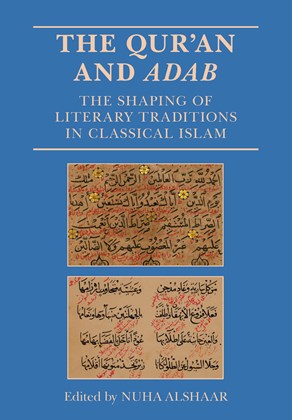The Qur’an and Adab The Shaping of Literary Traditions in Classical Islam
Oxford University Press in association with the Institute of Ismaili Studies
Though there have been many studies on the Qur’an’s importance in tafsīr (Qur’anic commentary), there are comparatively few which look at the reception of the Qur’an in other forms of literature. This volume seeks to rectify the gap in the scholarship by placing the Qur’an in its broader cultural and literary contexts. It explores the relation of Arabic (and Persian) classical literary traditions (adab) to the Qur’an from pre-Islamic times until the fifteenth century CE, focusing on the various ways in which the classical literati (udabāʾ) engaged with the Qur’anic text, linguistically, conceptually, structurally and aesthetically, to create works that combined the sacred with the profane, thereby blurring the boundaries between formal tafsīr and adab.
Through a detailed introduction and a series of case studies, the volume rethinks the concept of adab and the relation of scripture to humanistic traditions in classical Islam and questions the general classification of adab as belles-lettres. It explores the religious aesthetic found in different types of adab works – poetry, literary criticism, epistles, oratory traditions, anthologies, ‘mirrors for princes’, folklore and mystical/Sufi literature.
The key themes of the contributions are the intertextuality between pre-lslamic poetry and the Qur’an, and the innumerable approaches to the Qur’an by classical authors and poets. Discussed here are the various citation techniques employed in the udabāʾ’s borrowing of Qur’anic language, concepts and stories. The chapters explore how the use of these techniques reflect a hermeneutical involvement with the Qur’an and how the choice of these techniques was determined by the literary conventions of the particular genres and contexts within which the udabāʾ were working, as well as by their authorial intention, and theological and ideological outlooks. Also highlighted here is the link between the functions ascribed to Qur’anic quotations in a specific text and the need to convey a particular message to specific audiences.
Collectively, these contributions by leading scholars offer a new, interdisciplinary approach to understanding the interaction of the literary traditions of classical Islam with the Qur’an. Conversely, the analysis of these literary works enhances the understanding of the Qur’an’s reception during the period studied. Students and specialists in the field of Qur’anic Studies, Literature and Religion will welcome this volume.
List of Illustrations
Notes on Contributors
Note on Transliteration, Conventions and Abbreviations
Preface
1. Introduction: The Relation of Adab to the Qur’an: Conceptual and Historical Framework
Nuha Alshaar
Section I: The Qur'an and Classical Arabic Poetry: Intertextuality and Sensibilities
2. The ‘Discovery of Writing’ in the Qur’an: Tracing a Cultural Shift in Arab Late Antiquity
Angelika Neuwirth
3. The Qur’an and the Character of Pre-Islamic Poetry: The Dāliyya of al-Aswad b. Yaʿfur al-Nahshalī (d. c. 600 CE)
Ghassan El-Massri
4. Abbasid Poets and the Qur’an
Beatrice Gruendler
Section II: The Qur’an in Literary Criticism
5. The Qur’an in Kitāb al-Badīʿ by Ibn al-Muʿtazz (d. 296/908)
Geert Jan van Gelder
6. ‘I See a Distant Fire’: Thaʿālibī’s (d. 429/1030) Kitāb al-Iqtibās min al-Qurʾān al-Karīm
Bilal Orfali and Maurice Pomerantz
Section III: The Qur’an as a Moral, Literary and Aesthetic Model
7. The Place of the Qur’an in ‘The Sermons and Exhortations’ of Abū ʿUbayd (d. 224/838)
Andrew Rippin
8. Rhythmical Anxiety: Notes on Abū’l-ʿAlāʾ al-Maʿarrī’s (d. 449/1058) al-Fuṣūl wa’l-Ghāyāt and Its Reception
Devin Stewart
9. The Qur’an and the Aesthetics of Adab: Ḥikāyat Abīl-Qāsim al-Baghdādī by Abū’l-Muṭahhar al-Azdī (fl. Fifth/Eleventh Century)
Sarah R. bin Tyeer
Section IV: Approaches to the Qur’an in Adab: Five Case Studies
10. Qur’an Citation in Early Arabic Oration (Khuṭba): Mnemonic, Liturgical, and Testimonial Functions
Tahera Qutbuddin
11. The Impact of the Qur’an on the Epistolography of ʿAbd al-Ḥamīd b. Yaḥyā al-Kātib (d. 132/750)
Wadād al-Qāḍī
12. The Qur’an in Literary Anthologies: A Case Study of al-ʿIqd al-Farīd by Ibn ʿAbd Rabbih al-Andalusī (d. 328/940)
Nuha Alshaar
13. Wisdom and Justice: The Reception of the Qur’an in Some Arabic and Persian Mirrors for Princes
Louise Marlow
14. Solomon’s Ring in the Arabic Literary Imaginary
Wen-chin Ouyang
Section V: The Qur’an in Sufi Literature
15. Sufi Negotiation of the Qur’anic Text and its Prophetic Stories in the Literature of Abū Saʿīd al-Kharrāz (d. 286/899)
Nada Saab
16. Ibn ʿArabī (d. 637/1240) and the Qur’an: A Series of Poems
Denis McAuley
17. ‘Serving from Afar’: Jalāl al-Dīn al-Rūmī (d. 672/1273) on the Adab of Interpreting the Qur’an
Steffen Stelzer
Bibliography
Index of Qur’anic Citations
General Index
‘This collection treats a significant issue – the relation of the Qur’an to the literary imagination; the analyses presented here will surely stimulate further scholarly consideration of the relation of scripture to humanistic traditions in classical Islam.’
– Paul Heck, Professor, Department of Theology, Georgetown University
‘This is a rich and eminently readable collection of articles. The volume will be a welcome addition to Qur’anic studies as well as literary studies for its wide-ranging exploration of the connection between the Qur’an and adab.’
– Asma Afsaruddin, Professor, Department of Near Eastern Languages and Cultures, Indiana University Bloomington
Nuha Alshaar (Phd, University of Cambridge) has been a Research Associate at the Institute of Ismaili Studies since 2009, focusing on classical literary traditions (adab). She teaches Islamic Intellectual History and Thought as well as Arabic Literature at the American University of Sharjah. She has taught at various academic institutions, including the School of Oriental and African Studies. Her publications include Ethics in Islam: Friendship in the Political Thought of al-Tawḥīdī and his Contemporaries (Abingdon, Oxon, 2015) and the co-edited volume Sources and Approaches across Disciplines in Near Eastern Studies (Leuven, 2013), with Verena Klemm. Currently, she is preparing a volume of the Anthology of Qur’anic Commentaries based on Qur’an verses on ethics, as well as a critical edition, with an introduction, of The Layered Ordering of the World, in the Epistles of the Brethren of Purity, as part of the Brethren of Purity Series.

